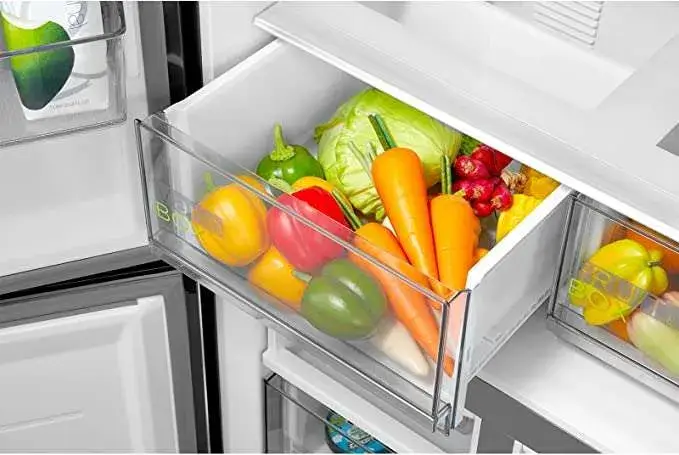If you need to store food for a long time, the best freezer type is a chest freezer. Chest freezers are more spacious, energy-efficient, and reliable than other types of freezers. They also prevent freezer burn and keep food frozen longer in case of a power outage. In this article, we will explain why chest freezers are the best choice for long term storage and how to use them effectively.
What are the Benefits of Chest Freezers?
Chest freezers are large, box-shaped appliances that have a hinged lid that opens upward. They come in different sizes, from compact models that can fit in a small space to commercial ones that can store hundreds of pounds of food. Here are some of the benefits of chest freezers for long term storage:
- More space: Chest freezers have more usable space than upright freezers or refrigerator-freezer combinations. They can accommodate bulky items that may not fit well in other types of freezers, such as large cuts of meat, whole turkeys, or bags of ice. They also have removable baskets or dividers that can help organize smaller items, such as frozen vegetables, fruits, or meals.
- More energy-efficient: Chest freezers use less electricity than other types of freezers because they have better insulation and less air circulation. They also have a manual defrost system, which means they do not have a fan or a heating element that consumes power to prevent ice buildup. According to Consumer Reports, chest freezers can save up to $20 per year in energy costs compared to upright freezers.
- More reliable: Chest freezers are less likely to break down or malfunction than other types of freezers because they have fewer moving parts and less exposure to dust and dirt. They also have a longer lifespan, lasting up to 20 years or more with proper maintenance.
- More protection: Chest freezers are better at preventing freezer burn, which is a condition that occurs when food loses moisture and flavor due to exposure to cold air. Because chest freezers have a tight seal and minimal air movement, they keep food frozen more evenly and consistently. They also have a lower temperature, usually around -18°C (0°F) or lower, which slows down the deterioration of food quality.
- More security: Chest freezers are more resilient to power outages than other types of freezers because they retain the cold air inside. According to the U.S. Department of Agriculture, a full chest freezer can keep food safe for 48 hours or more without power, while a half-full one can last for 24 hours. This can be a lifesaver in case of emergencies or natural disasters.
How to Use Chest Freezers Effectively?
While chest freezers have many advantages, they also have some drawbacks that need to be considered. For example, chest freezers can take up a lot of floor space and require enough headroom to open the lid. They can also be hard to access and organize, especially if they are too deep or too full. Here are some tips on how to use chest freezers effectively for long term storage:
- Choose the right size and location: Before buying a chest freezer, measure the space where you plan to put it and compare it with the dimensions of the freezer. Make sure you have enough room to open the lid and reach the bottom. Also, choose a location that is convenient, dry, and well-ventilated. Avoid placing the freezer near heat sources, such as stoves, radiators, or direct sunlight, as they can affect the performance and efficiency of the freezer.
- Label and date everything: To avoid confusion and waste, label and date everything you put in the chest freezer. Use a permanent marker or a freezer-safe tape to write the name, quantity, and expiration date of the food. You can also use color-coded labels or stickers to categorize the food by type, such as meat, poultry, seafood, dairy, vegetables, fruits, or prepared meals. This will help you find what you need quickly and easily.
- Pack and store food properly: To preserve the quality and safety of the food, pack and store it properly in the chest freezer. Use airtight containers, freezer bags, or heavy-duty aluminum foil to wrap the food and prevent air and moisture from getting in. Squeeze out as much air as possible from the packages and seal them tightly. Arrange the food in a way that allows air to circulate around the packages and avoid overfilling the freezer. Leave some space between the packages and the walls of the freezer to allow for expansion. Store the food according to the recommended storage times, which vary depending on the type and condition of the food. Generally, frozen food can last from a few months to a few years, but the longer it is stored, the more it loses its quality and flavor.
- Keep an inventory and rotate the food: To avoid forgetting what you have in the chest freezer and wasting food, keep an inventory and rotate the food regularly. Make a list of the items you have in the freezer and update it every time you add or remove something. You can also use a freezer inventory app or a spreadsheet to keep track of the food. Rotate the food by using the first-in, first-out (FIFO) method, which means using the oldest items first and placing the newest ones in the back. This will ensure that you use the food before it expires or spoils.
Conclusion
Chest freezers are the best freezer type for long term storage because they offer more space, energy-efficiency, reliability, protection, and security than other types of freezers. However, they also require careful planning and maintenance to use them effectively. By following the tips above, you can make the most of your chest freezer and enjoy your food for a long time.

